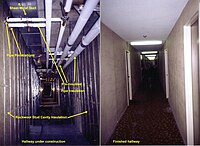
Photo from wikipedia
Abstract Reusing textile waste in building applications has the potential to reduce the environmental impact of two sectors considered the main sources of environmental pollution: the textile and the construction… Click to show full abstract
Abstract Reusing textile waste in building applications has the potential to reduce the environmental impact of two sectors considered the main sources of environmental pollution: the textile and the construction industries. Thus, the main goal of the present research study is to assess the potential conversion of wool waste into new raw materials suitable for building components. Hence, hygrothermal, acoustic and non-acoustic properties of nonwovens consisting of 100% wool waste fibers thermally bonded with polyester/copolyester bi-component fibers were explored. Five different density values (51, 90, 115, 136 and 167 kg/m3) were examined. Absorption coefficients ranging from 0.7 to almost 1 were measured above 1 kHz using 50 mm thick samples; thermal conductivity values from 0.044 to 0.057 W/(m·K) were obtained and a water vapour permeability close to 2·10-11 kg/(m·s·Pa) was found. Furthermore, a comparison between nonwovens under test and other previously experimented materials was carried out. Measurement results showed that the manufacturing processes mainly affected the sound absorption coefficients and the hygric properties of the fibrous nonwovens. Comparison between tested materials and those currently available on the market allows to state that the tested nonwovens may represent a valid alternative for building applications, thus opening a new research area.
Journal Title: Journal of Cleaner Production
Year Published: 2021
Link to full text (if available)
Share on Social Media: Sign Up to like & get
recommendations!